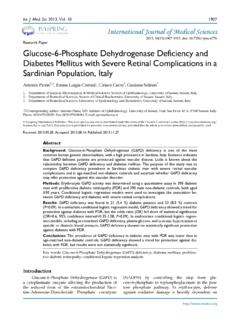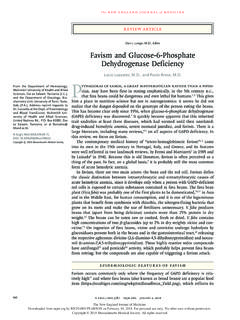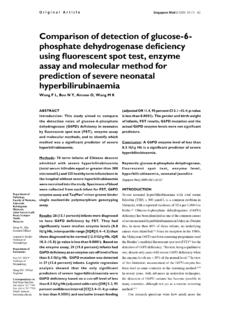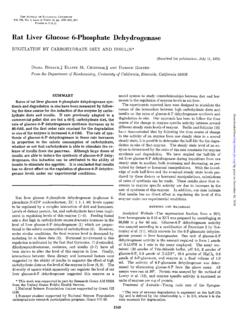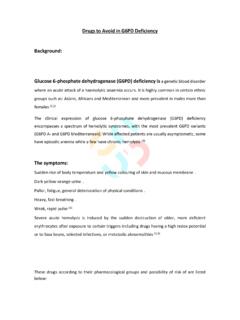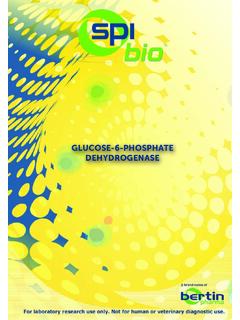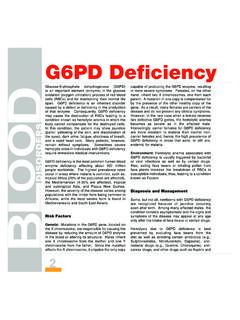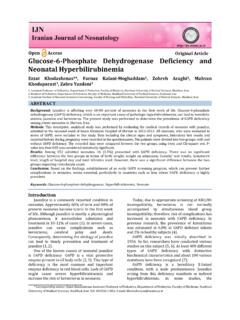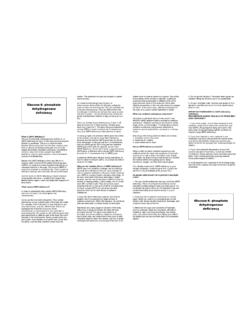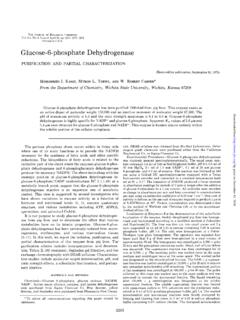Transcription of Structure of G6PD Glucose-6-Phosphate Dehydrogenase …
1 1 Glucose-6-Phosphate Dehydrogenase ( g6pd ) and MalariaStructure of g6pd The enzyme, Glucose-6-Phosphate Dehydrogenase , is comprised of a dimer or tetramer of identical polypeptide chains Each unit consists of 515 amino acids The single g6pd locus in humans is located on the telomeric region of the long arm of the X-chromosome Females have two X chromosomes, hence two copies of g6pd , while males have only one X chromosome and one copy of G6 PDFunction of g6pd g6pd is present in the cytoplasm of all cells of the body In Red Blood Cells (RBC), which lack nuclei, mitochondria, and other organelles, g6pd is particularly significant g6pd is involved in the first step of the Pentose phosphate Shunt Catalyzes the oxidation of Glucose-6-Phosphate to 6-Phosphogluconolactone (Phosphogluconate) Only source of NADPH and GSH, necessary for the reduction of hydrogen peroxide Hydrogen Peroxide is a strong oxidant that will degrade the RBC and cause hemolysis if it is not reducedGlucose-6-PhosphateDehydr ogenaseRed Blood Cell Metabolism2 H202 (Hydrogen Peroxide)2 H20 + 02 GSH(Reduced Glutathione)GSSG(Oxidized Glutathione)NADP+(Nicotinamide Adenine Di- phosphate )NADPH(Reduced Nicotinamide Adenine Di- phosphate )G-6-P( Glucose-6-Phosphate )G lucoseADPATPG lutathionePeroxidase6-P-G(6 Phospho-gluconate)F-6-P(Fructose-6-Phosp hate)PhosphoglucoisomerasePyr uvic Acid+ 2 ATP + 2H+70% Embden-Meyer hof PathwayGlycer aldehyde-3-P + CO2 + H+ + NADPH30% Pentose phosphate ShuntGlucokinaseGlutathioneReductaseFami lial Genetics of g6pd Five genotypes can form from combinations of one normal (GdB) and one deficient form ( , GdA-or GdMed) of g6pd Females GdB GdB, Homozygous Normal; Normal GdBGdA-, Heterozygous.
2 Heterozygote GdA-GdA-, Homozygous Deficient; g6pd Deficient Males GdB, Hemizygous Normal; Normal GdA-, Hemizygous Deficient; g6pd Deficient Mendelian TransmissionMalesFemalesGdBYGdBGdBGdBGdB GdMedGdB GdMedGdMedDaughtersSons2G6PD Heterozygotes Because of the random inactivation of one X chromosome in each female body cell, heterozygotes have two kinds of Red Blood Cells g6pd Normal g6pd Deficient Depending on which X chromosome was inactivated in the stem cell giving rise to the particular RBCG6PD VariantsFour most common variants out of 300+ knownGdBNormal ActivityAll WorldPopulationsGdANormal Activity; Aspartic acid substituted forasparagine at position 126, Guanine foradenine at DNA position 376 Africa (mostcommon variant)GdA-8 - 20% Normal Activity; Methionine for Valineat position 67 and Aspartic Acid for Asparagineat position 126, Adenine for Guanine atposition 202 and Guanine for Adenine atposition 376 AfricaGdMed< 5% Normal Activity; Phenylalanine for Serineat position 188.
3 Thymine for Cytosine atposition 563 Iran, Iraq, India,Pakistan,Greece, SardiniaG6PD Activity Declines with age of RBC GdBhas 62 day half-life for decay of activity Sustains GSH levels for 100 to 120 day RBC life span GdA-has normal activity when new, but the activity half-life is only 13 days Deficiency is due to instability of the enzyme GdMedhas greater instability with 8 day half-life New cells already have reduced activity, and mature RBC have enzyme levels < 1% normal activitySymptoms of g6pd deficiency g6pd deficiency is manifested as anemia, with RBCs being prematurely destroyed RBCs are also extremely susceptible to oxidative stress Neonatal jaundice is a yellowish discoloration of the whites of the eyes, skin, and mucous membranes caused by deposition of bile salts in these tissues A severe form of this is a direct result of insufficient activity of the g6pd enzyme in the liver In some cases, the neonatal jaundice is severe enough to cause death or permanent neurologic damage (Beutler, 1994).
4 Symptoms of g6pd deficiency, 2 Outside areas where dietary components cause hemolytic crises, infection is the most common cause of hemolysis and anemia in subjects with g6pd deficiency Oxidative metabolites produced by bacterial, viral, and rickettsial infections cause an anemic response Viral hepatitis, pneumonia, and typhoid fever are particularly likely to precipitate a hemolytic episode in g6pd deficient individualsG6PD Hemolysis Red blood cells will hemolyze or burst when the oxidant stress level becomes too high Hemolysis occurs in g6pd deficient individuals due to the consumption of certain foods or drugs Substances that increase the oxidation of glutathione, thereby diminishing the available GSH for oxidation of peroxide, creating a potential for hemolysis Fava Beans contains vicine and convicine whose metabolites can cause a hemolytic crisis in GdMedindividuals Many anti-malarial drugs, sulfonamides, sulfones and other drugs produce the same reaction in severely deficient individuals Can also cause the oxidation of hemoglobin, making it lose the ability to be a reversible oxygen carrier3 Favism The Fava Bean (Vicia faba) is a favored cultigen in areas where the GdMedallele is common Vicine and convicine make up about of the wet weight of the Fava bean These compounds metabolize to divicine and isouramil in the intestine These metabolites decrease RBC reduced glutathione (GSH) Increase the production of hydrogen peroxide and free radicals Creates a severe oxidant stress in g6pd deficient cells glucose -6-PhosphateDehydr ogenaseG6PD and Fava Beans2 H202(Hydrogen Peroxide)2 H20 + 02 GSH(Reduced Glutathione)GSSG(Oxidized Glutathione)NADP+(Nicotinamide Adenine Di- phosphate )NADPH(Reduced Nicotinamide Adenine Di- phosphate )G-6-P( Glucose-6-Phosphate )G lucoseADPATPG lutathionePeroxidase6-P-G(6-Phospho-gluc onate)
5 F-6-P(Fructose-6- phosphate )Phosphoglucoi somerasePyr uvic Acid+ 2 ATP + 2H+70% Embden-Meyer hof PathwayGlycer aldehyde-3-P + CO2 + H+ + NADPH30% Pentose phosphate ShuntGlucokinaseGlutathioneReductaseF ava Beans: Vicine and ConvicinePlasmodiumin the RBC Plasmodiumprotozoanspreferentially attack immature RBC but P. falciparumcan invade RBC of all ages Plasmodiumoxidizes RBC NADPH from the Pentose phosphate pathway for its metabolism This results in a deficiency of RBC GSH, most severe in g6pd deficient individuals, leading to peroxide-induced hemolysis which curtails the development of Plasmodium After several cell cycles the Plasmodiumcan adapt to produce its own g6pd , reducing the adaptive benefit of g6pd deficiencyGlucose-6-PhosphateDehydr ogenaseG6PD and Malaria2 H202(Hydrogen Peroxide)2 H20 + 02 GSH(Reduced Glutathione)GSSG(Oxidized Glutathione)NADP+(Nicotinamide Adenine Di- phosphate )NADPH(Reduced Nicotinamide Adenine Di- phosphate )G-6-P( Glucose-6-Phosphate )G lucoseADPATPG lutathionePeroxidase6-P-G(6 Phospho-gluconate)F-6-P(Fructose-6-Phosp hate)
6 PhosphoglucoisomerasePyr uvic Acid+ 2 ATP + 2H+70% Embden-Meyer hof PathwayGlycer aldehyde-3-P + CO2 + H+ + NADPH30% Pentose phosphate ShuntGlucokinaseGlutathioneReductasePlas modiumFava Beans and malaria Recall that fava beans contain compounds that metabolize to powerful oxidants In a cell that is oxidant-stressed by Plasmodiuminfection, the addition of another strong oxidant can lead to a rapid build-up of peroxide In vitroand in vivo(mouse) studies indicate a mild suppressant effect of divicine and isouramil on PlasmodiuminG6 PDnor mals This effect is even greater in g6pd deficient individualsGlucose-6-PhosphateDehydr ogenaseG6PD, Fava Beans, and Malaria2 H202(Hydrogen Peroxide)2 H20 + 02 GSH(Reduced Glutathione)GSSG(Oxidized Glutathione)NADP+(Nicotinamide Adenine Di- phosphate )NADPH(Reduced Nicotinamide Adenine Di- phosphate )G-6-P( Glucose-6-Phosphate )G lucoseADPATPG lutathionePeroxidase6-P-G(6-Phospho-gluc onate)F-6-P(Fructose-6- phosphate )Phospho glucoisomerasePyr uvic Acid+ 2 ATP + 2H+70% Embden-Meyer hof PathwayGlycer aldehyde-3-P + CO2 + H+ + NADPH30% Pentose phosphate ShuntGlucokinaseGlutathioneReductaseF ava Beans: Vicine and ConvicinePlasmodium4 Distribution of g6pd , Fava Beans, and MalariaCase Study: GdMedand Favism Fava bean cultivation is widespread, especially throughout the circum-Mediterranean region There is substantial overlap between the cultivation of fava beans and the GdMedallele Serious cases of hemolytic favism are described more than 2,000 years ago by Greeks About 1 in 12 cases of favism results in mortality Mostly affects children (up to 95% of cases) Why continue to cultivate fava beans?
7 Nutrition and Fava Beans Fava beans are only one of several legumes cultivated in the Mediterranean including chick peas, kidney beans, and lentils Fava beans are a highly productive crop and produce a high yield of protein by dry weight However, kidney beans and chick peas are more efficient in terms of the ratio of weight of protein consumed to weight gained in growing individuals Lentils are as efficient as fava beans Continued use where Favism rates are high must be due to other factorsResponses to Favism Mediterranean populations have developed several responses including food taboos, preparation techniques, and folk remedies Highly susceptible groups including children and pregnant women are frequently forbidden to consume fava beans Drying, soaking, and removing the skins appear to reduce toxicity Increasing sugar consumption reduces the severity of an impending hemolytic crisisContinued Cultivation There are three lines of evidence that suggest continued cultivation of Fava Beans in the face of Favism is related to malaria The association of divicine and isouramil with the suppression of Plasmodiumgrowth The clinal association of fava beans cultivation and malaria The overlap of the peak fava bean harvest and consumption times with the peak Anophelesmosquito breeding season Selection in Males Males are g6pd deficient or Normal malaria alone: Select for an increase in GdMedbecause of resistance to Plasmodium in g6pd RBCs Combination of malaria and Fava beans.
8 Select against GdMedthrough favism and hemolytic anemia Cooking and preparation techniques may buffer the favism selection Other genes may also buffer favism Acid Phosphatase B and b-Thallasemia reduce severity Decreased selection against GdBthrough increased resistance to Plasmodiumfrom fava beans5 Selection in Females malaria alone favors the heterozygotes Selects against GdB/GdB, most susceptible genotype to Plasmodium Anemia selects against GdMed/GdMed, but they are resistant to severe malaria symptoms Heterozygotes (GdB/GdMed) are favored Increased resistance to malaria compared to GdB/GdB Less susceptible to hemolytic crises from diet or infection than GdMed/GdMed The balance is complicated by the random deactivation of an X chromosome in the cells producing the RBCs Heterozygotes will range widely from about 20% normal to about 80% normal RBCs, and the response to malaria and other hemolytic crises will vary accordinglySelection in Females, 2 Combination of malaria and Fava beans complicates selection Fava beans intensify selection against GdMed/GdMed Favism and increased incidence of hemolytic anemia Cooking, preparation techniques, and other genes may buffer GdMed/GdMedfrom severe hemolytic crises Decreased selection against GdB/GdB Increased resistance to Plasmodiumfrom fava beans Heterozygotes (GdB/GdMed) are still most fit The differential between GdB/GdMedand GdB/GdBresistance to malaria is reduced (selection is weaker)
9 Selection differential may be stronger against GdMed/GdMedbecause of the increased incidence of hemolytic crises due to favism
